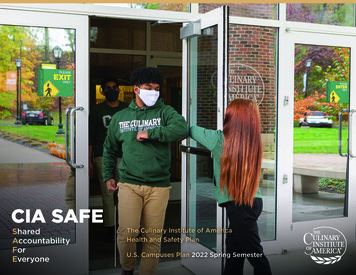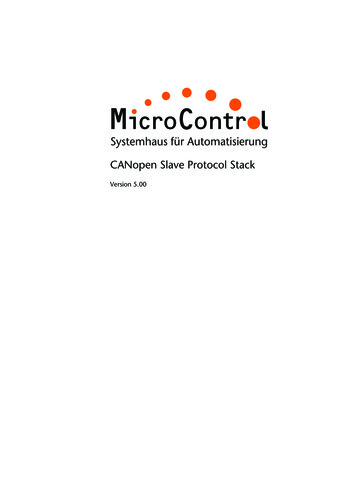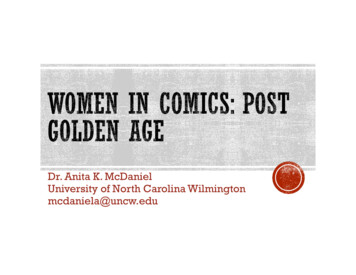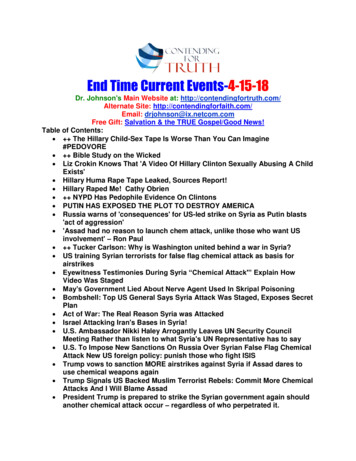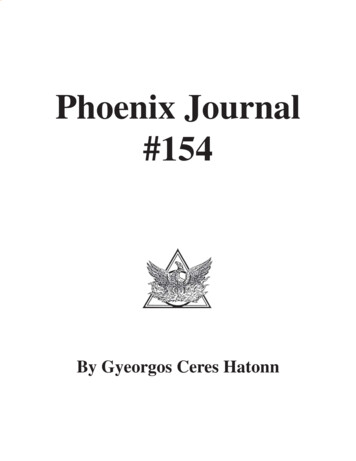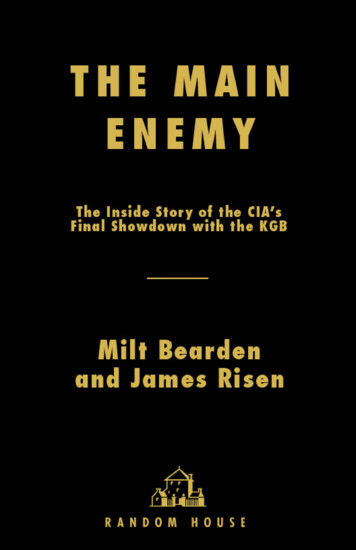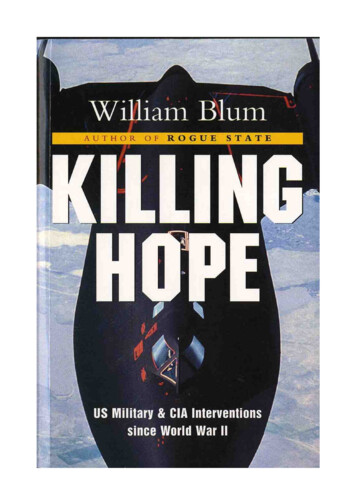
Transcription
Killing HopeU.S. Military and CIAInterventions Since WorldWar II – Part IWilliam BlumZed Books LondonKilling Hope was first published outside of North America by Zed Books Ltd, 7Cynthia Street, London NI 9JF, UK in 2003.Second impression, 2004Printed by Gopsons Papers Limited, Noida, Indiaw w w.zedbooks .demon .co .ukPublished in South Africa by Spearhead, a division of New Africa Books, PO Box23408, Claremont 7735This is a wholly revised, extended and updated edition of a book originally publishedunder the title The CIA: A Forgotten History (Zed Books, 1986)Copyright William Blum 2003The right of William Blum to be identified as the author of this work has been assertedby him in accordance with the Copyright, Designs and Patents Act 1988.Cover design by Andrew CorbettISBN 1 84277 368 2 hb ISBN 1 84277 369 0 pbSpearhead ISBN 0 86486 560 0 pb2
ContentsPART IIntroduction1.China 1945 to 1960s: Was Mao Tse-tung just paranoid?2.Italy 1947-1948: Free elections, Hollywood style3.Greece 1947 to early 1950s: From cradle of democracy to client state4.The Philippines 1940s and 1950s: America's oldest colony5.Korea 1945-1953: Was it all that it appeared to be?6.Albania 1949-1953: The proper English spy7.Eastern Europe 1948-1956: Operation Splinter Factor8.Germany 1950s: Everything from juvenile delinquency to terrorism9.Iran 1953: Making it safe for the King of Kings10.Guatemala 1953-1954: While the world watched11.Costa Rica mid-1950s: Trying to topple an ally, part I12.Syria 1956-1957: Purchasing a new government13.The Middle East 1957-1958:The Eisenhower Doctrine claims another backyard for America14.Indonesia 1957-1958: War and pornography15.Western Europe 1950s and 1960s: Fronts within fronts within fronts16.British Guiana 1953-1964: The CIA's international labor mafia17.Soviet Union late 1940s to 1960s: From spy planes to book publishing18.Italy 1950s to 1970s:Supporting the Cardinal's orphans and techno-fascism19.Vietnam 1950-1973: The Hearts and Minds Circus20.Cambodia 1955-1973:Prince Sihanouk walks the high-wire of neutralism21.Laos 1957-1973: L'Armee Clandestine22.Haiti 1959-1963: The Marines land, again23.Guatemala 1960: One good coup deserves another24.France/Algeria 1960s: L'etat, c'est la CIA620273338445456606371828425.26.27.153156Ecuador 1960-1963: A textbook of dirty tricksThe Congo 1960-1964: The assassination of Patrice LumumbaBrazil 1961-1964:Introducing the marvelous new world of death squads28.Peru 1960-1965: Fort Bragg moves to the jungle29.Dominican Republic 1960-1966:Saving democracy from communism by getting rid of democracy30.Cuba 1959 to 1980s: The unforgivable revolution31.Indonesia 1965:Liquidating President Sukarno . and 500,000 othersEast Timor 1975: And 200,000 more32.Ghana 1966: Kwame Nkrumah steps out of line33.Uruguay 1964-1970: Torture—as American as apple pie34.Chile 1964-1973:A hammer and sickle stamped on your child's foreheadNotes PART 1992012072173
PART 51.52.53.54.55.56.Greece 1964-1974:"Fuck your Parliament and your Constitution,"said thePresident of the United StatesBolivia 1964-1975:Tracking down Che Guevara in the land of coup d'etatGuatemala 1962 to 1980s: A less publicized "final solution"Costa Rica 1970-1971: Trying to topple an ally, part IIIraq 1972-1975:Covert action should not be confused with missionary workAustralia 1973-1975: Another free election bites the dustAngola 1975 to 1980s: The Great Powers Poker GameZaire 1975-1978: Mobutu and the CIA, a marriage made in heavenJamaica 1976-1980: Kissinger's ultimatumSeychelles 1979-1981: Yet another area of great strategic importanceGrenada 1979-1984:Lying—one of the few growth industries in WashingtonMorocco 1983: A video nastySuriname 1982-1984: Once again, the Cuban bogeymanLibya 1981-1989: Ronald Reagan meets his matchNicaragua 1978-1990: Destabilization in slow motionPanama 1969-1991: Double-crossing our drug supplierBulgaria 1990/Albania 1991:Teaching Communists what democracy is all aboutIraq 1990-1991: Desert holocaustAfghanistan 1979-1992: America's JihadEl Salvador 1980-1994: Human rights, Washington styleHaiti 1986-1994: Who will rid me of this turbulent priest?The American Empire: 1992 to 90305314320338352370383Notes PART IIAppendix I: This is How the Money Goes RoundAppendix II: Instances of Use of United States Armed Forces Abroad, 1798-1945Appendix III: U.S. Government Assassination PlotsIndexAbout the Author314 320 338 352 370 383 393 452 454 463 465 4704
Author's NoteThe last major revision of this book appeared in 1995. Since that time various minorchanges have been made with each new printing. The present edition contains somerevisions to the Introductions which appeared in the first two editions and these twoearlier Introductions have been combined into one. The major change to be found in thepresent volume is the addition at the end of a new chapter, "The American Empire:1992 to present", which offers a survey of US interventions during the 1990s and up tothe present, and attempts to describe the evolution of US foreign policy fromintervention ism to the openly proclaimed goal of world domination.—May 20035
IntroductionA Brief History of the Cold War and Anti-communismOur fear that communism might someday take overmost of the world blinds us to the fact that anticommunism already has.—Michael Parenti1It was in the early days of the fighting in Vietnam that a Vietcong officer said tohis American prisoner: "You were our heroes after the War. We read American booksand saw American films, and a common phrase in those days was "to be as rich and aswise as an American". What happened?"2An American might have been asked something similar by a Guatemalan, anIndonesian or a Cuban during the ten years previous, or by a Uruguayan, a Chilean or aGreek in the decade subsequent. The remarkable international goodwill and credibilityenjoyed by the United States at the close of the Second World War was dissipatedcountry-by-country, intervention-by-intervention. The opportunity to build the warravaged world anew, to lay the foundations for peace, prosperity and justice, collapsedunder the awful weight of anti-communism.The weight had been accumulating for some time; indeed, since Day One of theRussian Revolution. By the summer of 1918 some 13,000 American troops could befound in the newly-born Union of Soviet Socialist Republics. Two years and thousandsof casualties later, the American troops left, having failed in their mission to "strangle atits birth" the Bolshevik state, as Winston Churchill put it.3The young Churchill was Great Britain's Minister for War and Air during thisperiod. Increasingly, it was he who directed the invasion of the Soviet Union by theAllies (Great Britain, the US, France, Japan and several other nations) on the side of thecounter-revolutionary "White Army". Years later, Churchill the historian was to recordhis views of this singular affair for posterity:Were they [the Allies] at war with Soviet Russia? Certainly not; but they shotSoviet Russians at sight. They stood as invaders on Russian soil. They armed theenemies of the Soviet Government. They blockaded its ports, and sunk itsbattleships. They earnestly desired and schemed its downfall. But war—shocking!Interference—shame! It was, they repeated, a matter of indifference to them howRussians settled their own internal affairs. They were impartial—Bang!4What was there about this Bolshevik Revolution that so alarmed the mostpowerful nations in the world? What drove them to invade a land whose soldiers hadrecently fought alongside them for over three years and suffered more casualties thanany other country on either side of the World War?The Bolsheviks had had the audacity to make a separate peace with Germany inorder to take leave of a war they regarded as imperialist and not in any way their war,and to try and rebuild a terribly weary and devastated Russia. But the Bolsheviks haddisplayed the far greater audacity of overthrowing a capitalist- feudal system andproclaiming the first socialist state in the history of the world. This was uppityness writincredibly large. This was the crime the Allies had to punish, the virus which had to beeradicated lest it spread to their own people.6
The invasion did not achieve its immediate purpose, but its consequences werenonetheless profound and persist to the present day. Professor D.F. Fleming, theVanderbilt University historian of the Cold War, has noted:For the American people the cosmic tragedy of the interventions in Russia doesnot exist, or it was an unimportant incident long forgotten. But for the Sovietpeoples and their leaders the period was a time of endless killing, of looting andrapine, of plague and famine, of measureless suffering for scores of millions—an experience burned into the very soul of a nation, not to be forgotten for manygenerations, if ever. Also for many years the harsh Soviet regimentations couldall be justified by fear that the capitalist powers would be back to finish the job.It is not strange that in his address in New York, September 17, 1959, PremierKhrushchev should remind us of the interventions, "the time you sent yourtroops to quell the revolution", as he put it.5In what could be taken as a portent of superpower insensitivity, a 1920 Pentagonreport on the intervention reads: "This expedition affords one of the finest examples inhistory of honorable, unselfish dealings . under very difficult circumstances to behelpful to a people struggling to achieve a new liberty."6History does not tell us what a Soviet Union, allowed to develop in a "normal"way of its own choosing, would look like today. We do know, however, the nature of aSoviet Union attacked in its cradle, raised alone in an extremely hostile world, and,when it managed to survive to adulthood, overrun by the Nazi war machine with theblessings of the Western powers. The resulting insecurities and fears have inevitably ledto deformities of character not unlike that found in an individual raised in a similar lifethreatening manner.We in the West are never allowed to forget the political shortcomings (real andbogus) of the Soviet Union; at the same time we are never reminded of the historywhich lies behind it. The anti-communist propaganda campaign began even earlier thanthe military intervention. Before the year 1918 was over, expressions in the vein of"Red Peril", "the Bolshevik assault on civilization", and "menace to world by Reds isseen" had become commonplace in the pages of the New York Times.During February and March 1919, a US Senate Judiciary Subcommittee heldheatings before which many "Bolshevik horror stories" were presented. The character ofsome of the testimony can be gauged by the headline in the usually sedate Times of 12February 1919:DESCRIBE HORRORS UNDER RED RULE. R.E. SIMONSAND W.W. WELSH TELL SENATORS OF BRUTALITIES OFBOLSHEV1KI— STRIP WOMEN IN STREETS—PEOPLE OFEVERY CLASS EXCEPT THE SCUM SUBJECTED TOVIOLENCE BY MOBS.Historian Frederick Lewis Schuman has written: "The net result of these hearings. was to picture Soviet Russia as a kind of bedlam inhabited by abject slavescompletely at the mercy of an organization of homicidal maniacs whose purpose was todestroy all traces of civilization and carry the nation back to barbarism."7Literally no story about the Bolsheviks was too contrived, too bizarre, toogrotesque, or too perverted to be printed and widely believed—from women beingnationalized to babies being eaten (as the early pagans believed the Christians guilty ofdevouring their children; the same was believed of the jews in the Middle Ages). Thestory about women with all the lurid connotations of state property, compulsory7
marriage, "free love", etc. "was broadcasted over the country through a thousandchannels," wrote Schuman, "and perhaps did more than anything else to stamp theRussian Communists in the minds of most American citizens as criminal perverts".8This tale continued to receive great currency even after the State Department wasobliged to announce that it was a fraud. (That the Soviets eat their babies was still beingtaught by the John Birch Society to its large audience at least as late as 1978.)9By the end of 1919, when the defeat of the Allies and the White Army appearedlikely, the New York Times treated its readers to headlines and stories such as thefollowing:30 Dec. 1919: "Reds Seek War With America"9 Jan. 1920: "'Official quartets' describe the Bolshevist menace in the Middle East as ominous"11 Jan. 1920: "Allied officials and diplomats [envisage] a possible invasion of Europe"13 Jan. 1920: "Allied diplomatic circles" fear an invasion of Persia16 Jan. 1920: A page-one headline, eight columns wide:"Britain Facing War With Reds, Calls Council In Paris.""Well-informed diplomats" expect both a military invasion of Europe and a Sovietadvance into Eastern and Southern Asia.The following morning, however, we could read: "No War With Russia, Allies To Trade WithHer"7 Feb. 1920: "Reds Raising Army To Attack India"11 Feb. 1920: "Fear That Bolsheviki Will Now Invade Japanese Territory"Readers of the New York Times were asked to believe that all these invasionswere to come from a nation that was shattered as few nations in history have been; anation still recovering from a horrendous world war; in extreme chaos from afundamental social revolution that was barely off the ground; engaged in a brutal civilwar against forces backed by the major powers of the world; its industries, neveradvanced to begin with, in a shambles; and the country in the throes of a famine thatwas to leave many millions dead before it subsided.In 1920, The New Republic magazine presented a lengthy analysis of the newscoverage by the New York Times of the Russian Revolution and the intervention.Amongst much else, it observed that in the two years following the November 1917revolution, the Times had stated no less than 91 times that "the Soviets were nearingtheir rope's end or actually had reached it."10If this was reality as presented by the United States' "newspaper of record", onecan imagine only with dismay the witch's brew the rest of the nation's newspapers werefeeding to their readers.This, then, was the American people's first experience of a new socialphenomenon that had come upon the world, their introductory education about theSoviet Union and this thing called "communism". The students have never recoveredfrom the lesson. Neither has the Soviet Union.The military intervention came to an end but, with the sole and partial exceptionof the Second World War period, the propaganda offensive has never let up. In 1943Life magazine devoted an entire issue in honor of the Soviet Union's accomplishments,going fat beyond what was demanded by the need for wartime solidarity, going so far asto call Lenin "perhaps the greatest man of modern times".11 Two years later, however,with Harry Truman sitting in the White House, such fraternity had no chance ofsurviving. Truman, after all, was the man who, the day after the Nazis invaded theSoviet Union, said: "If we see that Germany is winning, we ought to help Russia, and ifRussia is winning, we ought to help Germany, and that way let them kill as many aspossible, although I don't want to see Hitler victorious in any circumstances."128
Much propaganda mileage has been squeezed out of the Soviet-German treaty of1939, made possible only by entirely ignoring the fact that the Russians were forcedinto the pact by the repeated refusal of the Western powers, particularly the UnitedStates and Great Britain, to unite with Moscow in a stand against Hitler;13 as theylikewise refused to come to the aid of the socialist-oriented Spanish government undersiege by the German, Italian and Spanish fascists beginning in 1936. Stalin realized thatif the West wouldn't save Spain, they certainly wouldn't save the Soviet Union.From the Red Scare of the 1920s to the McCarthyism of the 1950s to the ReaganCrusade against the Evil Empire of the 1980s, the American people have been subjectedto a relentless anti- communist indoctrination. It is imbibed with their mother's milk,pictured in their comic books, spelled out in their school books; their daily paper offersthem headlines that tell them all they need to know; ministers find sermons in it,politicians ate elected with it, and Reader's Digest becomes rich on it.The fiercely-held conviction inevitably produced by this insidious assault uponthe intellect is that a great damnation has been unleashed upon the world, possibly bythe devil himself, but in the form of people; people not motivated by the same needs,feats, emotions, and personal morality that govern others of the species, but peopleengaged in an extremely clever, monolithic, international conspiracy dedicated to takingover the world and enslaving it; for reasons not always clear perhaps, but evil needs nomotivation save evil itself. Moreover, any appearance or claim by these people to berational human beings seeking a better kind of world or society is a sham, a cover-up, todelude others, and proof only of their cleverness; the repression and cruelties whichhave taken place in the Soviet Union are forever proof of the bankruptcy of virtue andthe evil intentions of these people in whichever country they may be found, underwhatever name they may call themselves: and, most important of all, the only choiceopen to anyone in the United States is between the American Way of Life and theSoviet Way of Life, that nothing lies between or beyond these two ways of making theworld.This is how it looks to the simple folk of America. One finds that thesophisticated, when probed slightly beneath the surface of their academic language, seeit exactly the same way.To the mind carefully brought to adulthood in the United States, the truths of anticommunism are self-evident, as self-evident as the flatness of the world once was to anearlier mind; as the Russian people believed that the victims of Stalin's purges weretruly guilty of treason.The foregoing slice of American history must be taken into account if one is tomake sense of the vagaries of American foreign policy since the end of World War II,specifically the record, as presented in this book, of what the US military and the CIAand other branches of the US government have done to the peoples of the world.In 1918, the barons of American capital needed no reason for their war againstcommunism other than the threat to their wealth and privilege, although their oppositionwas expressed in terms of moral indignation.During the period between the two world wars, US gunboat diplomacy operatedin the Caribbean to make "The American Lake" safe for the fortunes of United Fruit andW.R. Grace & Co., at the same time taking care to warn of "the Bolshevik threat" to allthat is decent from the likes of Nicaraguan rebel Augusto Sandino.By the end of the Second World War, every American past the age of 40 had beensubjected to some 25 years of anti-communist radiation, the average incubation periodneeded to produce a malignancy. Anti-communism had developed a life of its own,independent of its capitalist father. Increasingly, in the post-war period, middle-aged9
Washington policy makers and diplomats saw the world out there as one composed of"communists" and "anti-communists", whether of nations, movements or individuals.This comic-strip vision of the world, with righteous American supermen fightingcommunist evil everywhere, had graduated from a cynical propaganda exercise to amoral imperative of US foreign policy.Even the concept of "non-communist", implying some measure of neutrality, hasgenerally been accorded scant legitimacy in this paradigm. John Foster Dulles, one ofthe major architects of post-war US foreign policy, expressed this succinctly in histypically simple, moralistic way: "For us there are two sorts of people in the world:there are those who are Christians and support free enterprise and there are the others."14As several of the case studies in the present hook confirm, Dulles put that creed intorigid practice.The word "communist" (as well as "Marxist") has been so overused and so abusedby American leaders and the media as to render it virtually meaningless. (The Left hasdone the same to the word "fascist".) But merely having a name for something—witchesor flying saucers—attaches a certain credence to it.At the same time, the American public, as we have seen, has been soundlyconditioned to react Pavlovianly to the term: it means, still, the worst excesses of Stalin,from wholesale purges to Siberian slave-labor camps; it means, as Michael Parenti hasobserved, that "Classic Marxist-Leninist predictions [concerning world revolution] aretreated as statements of intent directing all present-day communist actions."15 It means"us" against "them".And "them" can mean a peasant in the Philippines, a mural-painter in Nicaragua,a legally-elected prime minister in British Guiana, or a European intellectual, aCambodian neutralist, an African nationalist—all, somehow, part of the samemonolithic conspiracy; each, in some way, a threat to the American Way of Life; noland too small, too poor, or too far away to pose such a threat, the "communist threat".The cases presented in this book illustrate that it has been largely irrelevantwhether the particular targets of intervention—be they individuals, political parties,movements or governments—called themselves "communist" or not. It has matteredlittle whether they were scholars of dialectical materialism or had never heard of KarlMarx; whether they were atheists or priests; whether a strong and influential CommunistParty was in the picture or not; whether the government had come into being throughviolent revolution or peaceful elections . all have been targets, all "communists".It has mattered still less that the Soviet KGB was in the picture. The assertion hasbeen frequently voiced that the CIA carries out its dirty tricks largely in reaction tooperations of the KGB which have been "even dirtier". This is a lie made out of wholecloth. There may be an isolated incident of such in the course of the CIA's life, but it haskept itself well hidden. The relationship between the two sinister agencies is marked byfraternization and respect for fellow professionals more than by hand-to-hand combat.Former CIA officer John Stockwell has written:Actually, at least in more routine operations, case officers most fear the USambassador and his staff, then restrictive headquarters cables, then curious,gossipy neighbors in the local community, as potential threats to operations. Nextwould come the local police, then the press. Last of all is the KGB—in my twelveyears of case officering I never saw or heard of a situation in which the KGBattacked or obstructed a CIA operation.16Stockwell adds that the various intelligence services do not want their world to be"complicated" by murdering each other.10
It isn't done. If a CIA case officer has a flat tire in the dark of night on a lonelyroad, he will not hesitate to accept a ride from a KGB officer—likely the twowould detour to some bar for a drink together. In fact CIA and KGB officersentertain each other frequently in their homes. The CIA's files are full ofmention of such relationships in almost every African station.17Proponents of "fighting fire with fire" come perilously close at times to arguingthat if the KGB, for example, had a hand in the overthrow of the Czechoslovakgovernment in 1968, it is OK for the CIA to have a hand in the overthrow of the Chileangovernment in 1973. It's as if the destruction of democracy by the KGB deposits fundsin a bank account from which the CIA is then justified in making withdrawals.What then has been the thread common to the diverse targets of Americanintervention which has brought down upon them the wrath, and often the firepower, ofthe world's most powerful nation? In virtually every case involving the Third Worlddescribed in this book, it has been, in one form or another, a policy of "selfdetermination": the desire, born of perceived need and principle, to pursue a path ofdevelopment independent of US foreign policy objectives. Most commonly, this hasbeen manifested in (a) the ambition to free themselves from economic and politicalsubservience to the United States; (b) the refusal to minimize relations with the socialistbloc, or suppress the left at home, or welcome an American military installation on theirsoil; in short, a refusal to be a pawn in the Cold War; or (c) the attempt to alter orreplace a government which held to neither of these aspirations; i.e., a governmentsupported by the United States.It cannot be emphasized too strongly that such a policy of independence has beenviewed and expressed by numerous Third World leaders and revolutionaries as one notto be equated by definition to anti-Americanism or pro-communism, but as simply adetermination to maintain a position of neutrality and non- alignment vis-a-vis the twosuperpowers. Time and time again, however, it will be seen that the United States wasnot prepared to live with this proposition. Arbenz of Guatemala, Mossadegh of Iran,Sukarno of Indonesia, Nkrumah of Ghana, Jagan of British Guiana, Sihanouk ofCambodia . all, insisted Uncle Sam, must declare themselves unequivocally on the sideof "The Free World" or suffer the consequences. Nkrumah put the case for nonalignment as follows:The experiment which we tried in Ghana was essentially one of developing thecountry in co-operation with the world as a whole. Non-alignment meant exactlywhat it said. We were not hostile to the countries of the socialist world in theway in which the governments of the old colonial territories were. It should beremembered that while Britain pursued at home coexistence with the SovietUnion this was never allowed to extend to British colonial territories. Books onsocialism, which were published and circulated freely in Britain, were banned inthe British colonial empire, and after Ghana became independent it was assumedabroad that it would continue to follow the same restrictive ideologicalapproach. When we behaved as did the British in their relations with thesocialist countries we were accused of being pro-Russian and introducing themost dangerous ideas into Africa. 18It is reminiscent of the 19th-century American South, where many Southernerswere deeply offended that so many of their black slaves had deserted to the Northernside in the Civil War. They had genuinely thought that the blacks should have beengrateful for all their white masters had done for them, and that they were happy andcontent with their lot. The noted Louisiana surgeon and psychologist Dr. Samuel A.11
Cartwright argued that many of the slaves suffered from a form of mental illness, whichhe called "drapetomania", diagnosed as the uncontrollable urge to escape from slavery.In the second half of the 20th-century, this illness, in the Third World, has usually beencalled "communism".Perhaps the most deeply ingrained reflex of knee-jerk anti- communism is thebelief that the Soviet Union (or Cuba or Vietnam, etc., acting as Moscow's surrogate] isa clandestine force lurking behind the facade of self-determination, stirring up the hydraof revolution, or just plain trouble, here, there, and everywhere; yet another incarnation,although on a far grander scale, of the proverbial "outside agitator", he who has madehis appearance regularly throughout history . King George blamed the French forinciting the American colonies to revolt . disillusioned American farmers and veteransprotesting their onerous economic circumstances after the revolution (Shays' Rebellion)were branded as British agents out to wreck the new republic . labor strikes in late19th-century America were blamed on "anarchists" and "foreigners", during the FirstWorld War on "German agents", after the war on "Bolsheviks".And in the 1960s, said the National Commission on the Causes and Prevention ofViolence, J. Edgar Hoover "helped spread the view among the police ranks that anykind of mass protest is due to a conspiracy promulgated by agitators, often Communists,'who misdirect otherwise contented people'."19The last is the key phrase, one which encapsulates the conspiracy mentality ofthose in power—the idea that no people, except those living under the enemy, could beso miserable and discontent as to need recourse to revolution or even mass protest; thatit is only the agitation of the outsider which misdirects them along this path.Accordingly, if Ronald Reagan were to concede that the masses of El Salvadorhave every good reason to rise up against their god-awful existence, it would bring intoquestion his accusation, and the rationale for US intervention, that it is principally(only?) the Soviet Union and its Cuban and Nicaraguan allies who instigate theSalvadoreans: that seemingly magical power of communists everywhere who, with atwist of their red wrist, can transform peaceful, happy people into furious guerrillas. TheCIA knows how difficult a feat this is. The Agency, as we shall see, tried to spark massrevolt in China, Cuba, the Soviet Union, Albania, and elsewhere in Eastern Europe witha singular lack of success. The Agency's scribes have laid the blame for these failureson the "closed" nature of the societies involved. But in non-communist countries, theCIA has had to resort to military coups or extra-legal chicanery to get its people intopower. It has never been able to light the fire of popular revolution.For Washington to concede merit and virtue to a particular Third Worldinsurgency would, moreover, raise the question: Why does not the United States, if itmust intervene, take the side of the rebels? Not only might this better serve the cause ofhuman rights and justice, but it woul
2. Italy 1947-1948: Free elections, Hollywood style 27 3. Greece 1947 to early 1950s: From cradle of democracy to client state 33 . "You were our heroes after the War. We read American books . enjoyed by the United States at the close of the Second World War was dissipated country-by-coun

